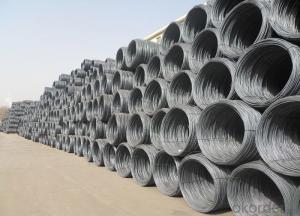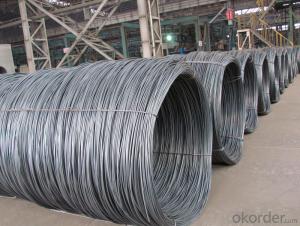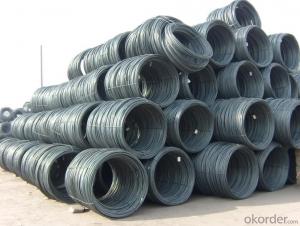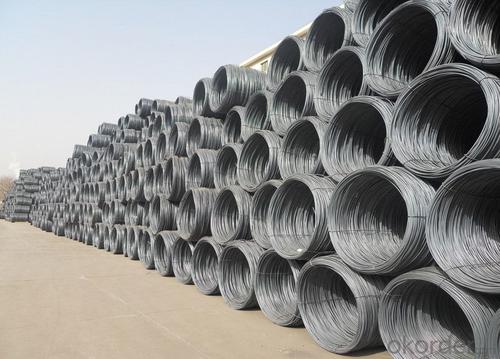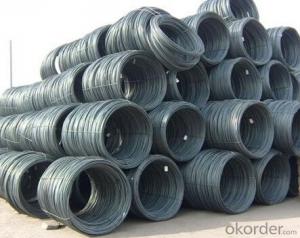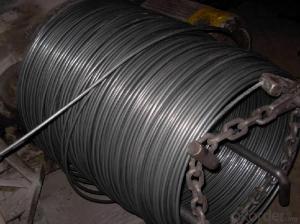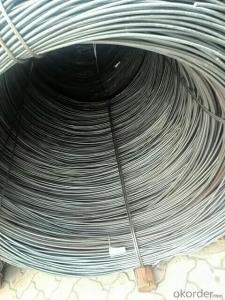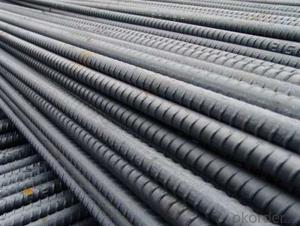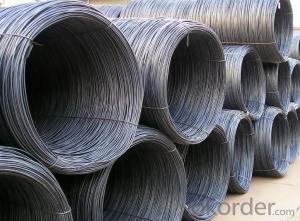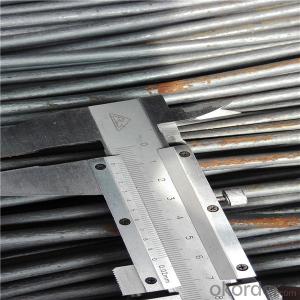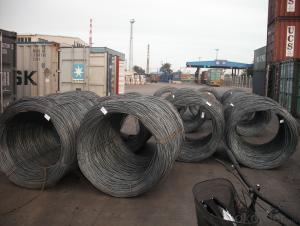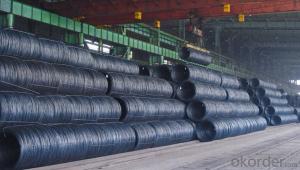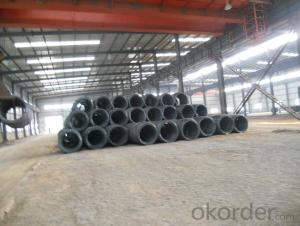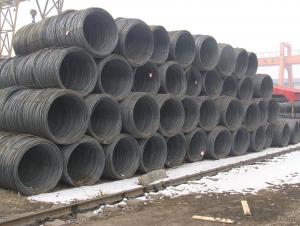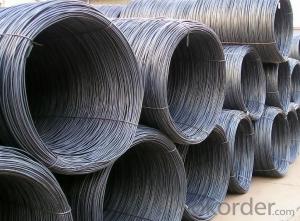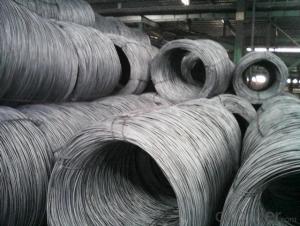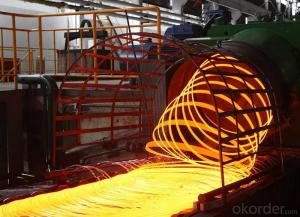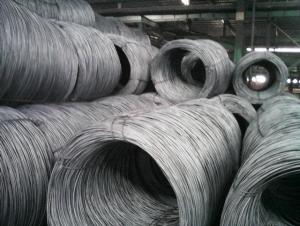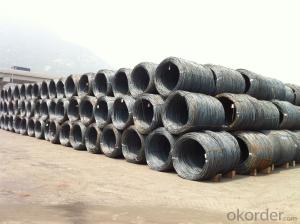Prime Hot Rolled Carbon Steel Wire Rod
- Loading Port:
- China Main Port
- Payment Terms:
- TT or LC
- Min Order Qty:
- 100 m.t.
- Supply Capability:
- 10000 m.t./month
OKorder Service Pledge
OKorder Financial Service
You Might Also Like
Product Description:
OKorder is offering Prime Hot Rolled Carbon Steel Wire Rod at great prices with worldwide shipping. Our supplier is a world-class manufacturer of steel, with our products utilized the world over. OKorder annually supplies products to African, South American and Asian markets. We provide quotations within 24 hours of receiving an inquiry and guarantee competitive prices.
Product Applications:
Prime Hot Rolled Carbon Steel Wire Rod are ideal for structural applications and are widely used in construction and manufacturing. Carbon steel wire rod is mainly used for reinforcement of reinforced concrete and welded structure or reprocessed (roberts , nail, etc.) materials, especially used to produce wire drawing, welding electrode, nails, spring, electronic, precise machinery parts and so on.
Product Advantages:
OKorder's Prime Hot Rolled Carbon Steel Wire Rod are durable, strong, and wide variety of sizes.
Main Product Features:
· Premium quality
· Prompt delivery & seaworthy packing (30 days after receiving deposit)
· Can be recycled and reused
· Mill test certification
· Professional Service
· Competitive pricing
Product Specifications:
Steel Grade: SAE1006-1018B
Standard: ASTM, GB
Diameter: 5.5mm, 6.5mm, 7mm,8mm,9mm,10mm,12mm,14mm
Type: in coil, coil weight around 2MT
Alloy or Not: Alloy
Technique: Hot Rolled
Place of Origin: China Mainland
Surface: round, no twisted, light and smooth
Trademark | Rank | Chemical composition (quality score) % | ||||||
C | Si | Mn | S | P | ||||
| ≤ |
| ≤ | ≤ | ||||
Q195 |
| 0.06-0.12 | 0.30 | 0.25 | 0.050 | 0.045 | ||
Q235 | A | 0.14-0.22 | 0.30 | 0.30-0.65 | 0.050 | 0.045 | ||
Q235 | B | 0.12-0.20 | 0.30 | 0.30-0.70 | 0.045 | 0.045 | ||
FAQ:
Q1: How many tons of steel products could be loaded in containers?
A1: Usually the steel products are delivered by bulk vessel because of the large quantity and the freight. However, there are no bulk vessel enter some seaports so that we have to deliver the cargo by containers. The 6m steel product can be loaded in 20FT container, but the quantity is changed according to the size, usually from 18tons to 25tons.
Q2: How do we guarantee the quality of our products?
A2: We have established an advanced quality management system which conducts strict quality tests at every step, from raw materials to the final product. At the same time, we provide extensive follow-up service assurances as required.
Q3: How soon can we receive the product after purchase?
A3: Within three days of placing an order, we will arrange production. The normal sizes with the normal grade can be produced within one month. The specific shipping date is dependent upon international and government factors, the delivery to international main port about 45-60days.
Images:
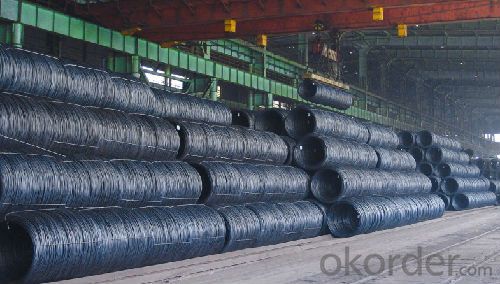
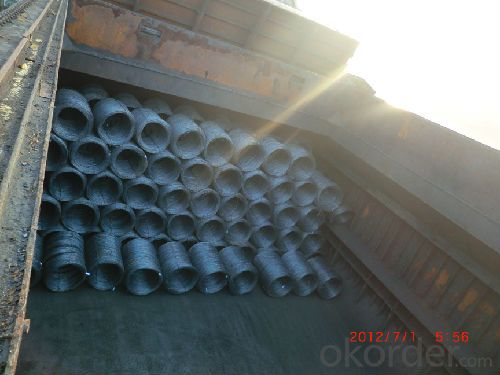
- Q: How is steel wire rod used in the manufacturing of wire forms for ski lifts?
- Steel wire rod is an essential component in the manufacturing of wire forms for ski lifts. These wire forms are responsible for providing the necessary support and strength to the ski lift system. Firstly, steel wire rod is used to create the primary cables that run along the ski lift structure. These cables bear the weight of the ski lift and its passengers, ensuring their safety and stability. The high tensile strength of steel wire rod is crucial in withstanding the heavy loads and stress that the ski lift system experiences during operation. Additionally, steel wire rod is utilized in the creation of the suspension cables that connect the ski lift cabins to the primary cables. These suspension cables play a vital role in keeping the cabins balanced and levelled while in motion. The durability and reliability of steel wire rod ensure that these suspension cables can withstand the constant movement and varying forces exerted on them. Moreover, steel wire rod is also used in the construction of safety cables that are installed as a precautionary measure. These safety cables act as a backup system, providing an additional level of security for the ski lift passengers. In case of any unforeseen event or malfunction, the safety cables ensure that the cabins remain securely attached to the primary cables, preventing any potential accidents. Overall, steel wire rod serves as the backbone of wire forms for ski lifts by providing the necessary strength, stability, and safety required for their operation. The quality and durability of steel wire rod play a crucial role in ensuring the reliability and longevity of ski lift systems, ultimately contributing to the safety and enjoyment of skiers and snowboarders.
- Q: How is the steel wire rod industry affected by fluctuations in raw material prices?
- The steel wire rod industry is significantly affected by fluctuations in raw material prices. Raw materials, such as iron ore, coal, and scrap metal, are essential for the production of steel wire rods. Any changes in the prices of these raw materials can have a direct impact on the cost of production for steel wire rod manufacturers. When raw material prices increase, it directly increases the input costs for steel wire rod production. This puts pressure on manufacturers to either absorb the higher costs, which can lead to reduced profit margins, or pass on the increased costs to customers through higher prices. In either case, it can impact the competitiveness of steel wire rod manufacturers in the market. On the other hand, when raw material prices decrease, it can provide some relief to steel wire rod manufacturers as it reduces their production costs. This can enable manufacturers to offer lower prices or maintain their profit margins while remaining competitive in the market. Fluctuations in raw material prices also affect the supply chain of the steel wire rod industry. Manufacturers rely on a steady supply of raw materials, and any disruption or volatility in prices can impact their ability to procure sufficient quantities of raw materials. This can cause delays in production, lead to higher inventory costs, and affect the overall productivity of the industry. Additionally, fluctuations in raw material prices can also impact the profitability of steel wire rod manufacturers. If raw material prices increase significantly and manufacturers are unable to pass on the increased costs to customers, it can result in reduced profitability and potentially even financial losses. Conversely, when raw material prices decrease, manufacturers may experience improved profitability. In conclusion, fluctuations in raw material prices have a direct impact on the steel wire rod industry. It affects the cost of production, competitiveness, supply chain, and profitability of manufacturers. As a result, industry players closely monitor and analyze raw material price trends to make informed decisions and mitigate the impacts of price fluctuations.
- Q: What are the standard dimensional accuracy requirements for steel wire rod?
- The standard dimensional accuracy requirements for steel wire rod depend on the specific industry or application, as different industries may have their own set of standards and specifications. However, in general, steel wire rod is expected to meet certain dimensional tolerances, which typically include requirements for diameter, roundness, straightness, and surface quality. These tolerances ensure consistency and quality in the production and use of steel wire rod.
- Q: How does steel wire rod compare to other materials, such as aluminum or copper?
- Steel wire rod is known for its exceptional strength and durability, making it a preferred choice in various industries. In comparison to materials like aluminum or copper, steel wire rod possesses superior tensile strength and a higher load-bearing capacity. Additionally, steel wire rod is more resistant to corrosion and can withstand higher temperatures. While aluminum and copper may offer certain advantages such as lighter weight or enhanced electrical conductivity, steel wire rod's strength and robustness make it an excellent choice for applications that require durability and structural integrity.
- Q: What are the factors that influence the cost of steel wire rod?
- There are several factors that influence the cost of steel wire rod. 1. Raw material prices: The cost of steel wire rod is heavily influenced by the prices of raw materials, particularly iron ore and scrap metal. Fluctuations in these prices can significantly impact the cost of production and, subsequently, the price of steel wire rod. 2. Demand and supply dynamics: The demand for steel wire rod in various industries, such as construction, automotive, and manufacturing, can impact its cost. If there is high demand and limited supply, the price tends to increase. Conversely, if demand is low and supply is abundant, the price may decrease. 3. Production and manufacturing costs: The cost of producing steel wire rod involves various expenses like labor, energy, transportation, and equipment maintenance. Any changes in these costs, such as wage increases or fluctuations in energy prices, can affect the final price of steel wire rod. 4. Currency exchange rates: Steel wire rod is often traded internationally, and fluctuations in currency exchange rates can impact its cost. If the domestic currency strengthens against foreign currencies, the cost of importing raw materials or exporting finished products may increase, leading to higher prices. 5. Government policies and regulations: Government policies and regulations, such as tariffs, import/export restrictions, and environmental regulations, can affect the cost of steel wire rod. These factors can influence the availability of raw materials, increase production costs, or create trade barriers, all of which can impact the final cost of steel wire rod. 6. Market competition: The level of competition in the steel wire rod market can influence its cost. Higher competition can lead to price competition among manufacturers, resulting in lower prices. On the other hand, if there are fewer suppliers, they may have more pricing power, resulting in higher prices. It is important to note that these factors are interrelated and can vary over time. Therefore, the cost of steel wire rod is subject to constant change, influenced by a combination of these factors and market dynamics.
- Q: What are the common applications of high-strength steel wire rod?
- High-strength steel wire rods are commonly used in a variety of applications, including construction, automotive, aerospace, and manufacturing industries. They are often used for reinforcement in concrete structures, such as bridges and buildings, due to their superior strength and durability. In the automotive industry, high-strength steel wire rods are utilized for the production of suspension systems, seat frames, and safety components. They are also essential in the aerospace sector for manufacturing aircraft components and engines. Additionally, high-strength steel wire rods find applications in manufacturing processes, such as wire mesh, springs, and cables, due to their ability to withstand high stress and resist deformation.
- Q: How is steel wire rod classified based on its surface condition?
- Steel wire rod can be classified based on its surface condition into three main categories: 1) bright or untreated surface, 2) coated or galvanized surface, and 3) coated and drawn surface. 1) Bright or untreated surface: This refers to steel wire rod that has not undergone any surface treatment or coating. It has a clean and smooth surface, free from any contaminants or oxidation. Bright steel wire rod is commonly used in applications where a clean appearance or high conductivity is required, such as in the manufacturing of electrical wires, cables, and springs. 2) Coated or galvanized surface: Steel wire rod with a coated surface has been treated with a protective layer, typically through galvanization or coating with zinc, to enhance its corrosion resistance. This coating acts as a barrier against moisture and other corrosive elements, making the wire rod suitable for outdoor applications or environments with high humidity or exposure to chemicals. Coated steel wire rod is commonly used in construction, fencing, and automotive industries. 3) Coated and drawn surface: This refers to steel wire rod that has undergone both a coating and a drawing process. The coating is applied to the wire rod before it is drawn through a series of dies to reduce its diameter and increase its tensile strength. This process results in a smooth and uniform surface, with improved mechanical properties. Coated and drawn steel wire rod is commonly used in high-strength wire applications, such as wire ropes, tire reinforcement, and suspension springs. In summary, the classification of steel wire rod based on its surface condition helps to determine its suitability for different applications, taking into account factors such as corrosion resistance, conductivity, appearance, and mechanical properties.
- Q: How is the diameter of steel wire rod measured?
- The diameter of a steel wire rod is typically measured using a specialized tool called a micrometer. This tool allows for precise measurement of the wire's diameter by capturing the wire between its jaws and providing an accurate reading on a calibrated scale.
- Q: How is steel wire rod used in the manufacturing of wire forms for sliding doors?
- The manufacturing of wire forms for sliding doors relies heavily on steel wire rod. It acts as the main material for constructing the framework and structure of the wire forms. To begin with, steel wire rod is chosen for its exceptional tensile strength and durability, making it ideal for withstanding the constant movement and stress experienced by sliding doors. The wire rod undergoes a series of processes, including drawing and annealing, to enhance its mechanical properties and ensure it meets the necessary specifications. Following that, the steel wire rod is shaped into various sizes and shapes based on the specific design and requirements of the wire forms. This can be accomplished through techniques such as bending, cutting, and welding. The wire rod is manipulated to create the required curves, angles, and dimensions needed for constructing the sliding door wire forms. Once the wire forms are shaped, they undergo further processing to enhance their functionality and aesthetics. This may involve surface treatments like galvanizing or coating to provide corrosion resistance and improve the overall appearance of the wire forms. Lastly, the wire forms are assembled and integrated into the sliding door system. They are commonly used to support the door panels, guide the movement of the doors along the tracks, and provide stability and smooth operation. The steel wire rod ensures that the wire forms can endure the weight of the door panels and withstand frequent opening and closing without deforming or failing. In conclusion, steel wire rod plays a crucial role in the manufacturing of wire forms for sliding doors by providing strength, durability, and flexibility. It serves as the foundation of the wire forms, enabling them to function effectively and contribute to the overall performance of sliding doors.
- Q: What are the common production processes for neon-coated steel wire rod?
- The common production processes for neon-coated steel wire rod typically involve several steps. First, the steel wire rod is cleaned and prepared to remove any impurities. Then, it undergoes a coating process where a layer of neon-colored material is applied onto the surface of the wire rod. This coating can be achieved through various methods such as electroplating or powder coating. Once the wire rod is coated, it is cured or dried to ensure the neon coating adheres properly. Finally, the coated wire rod may undergo additional processes such as cutting, shaping, or bundling, depending on its intended use.
Send your message to us
Prime Hot Rolled Carbon Steel Wire Rod
- Loading Port:
- China Main Port
- Payment Terms:
- TT or LC
- Min Order Qty:
- 100 m.t.
- Supply Capability:
- 10000 m.t./month
OKorder Service Pledge
OKorder Financial Service
Similar products
Hot products
Hot Searches
Related keywords
